Connections (Jan-Feb 2022)
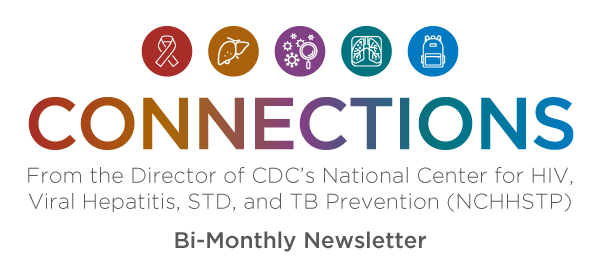
January – February 2022
From the Director - Jonathan Mermin, MD, MPH
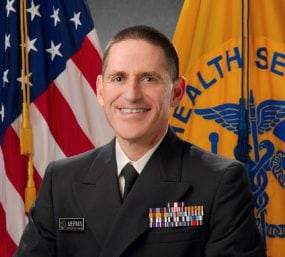
I want to thank you for your support and work in public health during the more than two years we have been navigating the SARS-CoV-2 pandemic. We faced many challenges, yet efforts to prevent HIV, viral hepatitis, STD, and TB, and promote school-based health and disease prevention among youth continued. Looking back at 2021, I want to share new guidance documents that are the result of rigorous research, broad collaboration, sound science, and thoughtful writing:
- CDC’s Division of Adolescent and School Health (DASH) — Guidance for COVID-19 Prevention in K-12 Schools providing schools, parents and administrators with new information on safely returning to school as well as guidance on promoting vaccination.
- CDC’s Division of HIV Prevention (DHP) — Clinical Practice Guideline for Preexposure Prophylaxis for HIV Prevention and Clinical Providers Supplement helping physicians prescribe PrEP medications and increase PrEP among all who can benefit.
- CDC’s Division of STD Prevention (DSTDP) — STI Treatment Guidelines, 2021 including notable updates from the 2015 guidelines, along with several online provider resources.
- CDC’s Division of Tuberculosis Elimination (DTBE) – Although not in 2021, Provisional CDC Guidance for the Use of Pretomanid as part of a Regimen [Bedaquiline, Pretomanid, and Linezolid (BPaL)] to Treat Drug-Resistant Tuberculosis Disease is now available. The new guidance contains considerations for clinicians, dosing and administration, precautions and adverse event monitoring, and microbiologic monitoring.
Lastly, these last few months have affected us all with yet another surge of SARS-CoV-2 infections and deaths coincident with the arrival of the Omicron variant during the holidays and into the new year. However, over the past 2 weeks, incidence has decreased considerably, providing some hope for reductions in mortality soon, and continued reductions in incidence and over the next month. Despite the ongoing pandemic, I hope you experienced some rest and joy over the holidays and felt encouraged to step into the new year with vigor and anticipation of a better year. Please enjoy reading the newly refreshed Connections newsletter, encourage your colleagues to subscribe, if they haven’t already, and share with others.
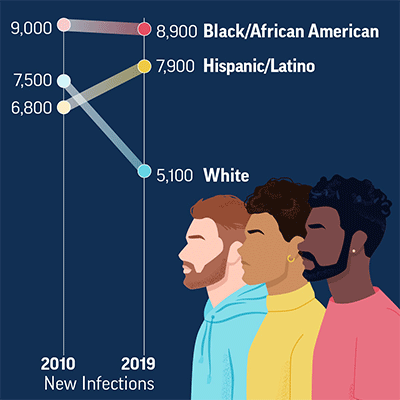
Despite advances in HIV prevention and treatment, gay and bisexual men continue to be disproportionately affected by HIV. The latest Vital Signs report presents inequities by race/ethnicity that exist in HIV prevention, diagnosis, and treatment among gay or bisexual men. Although new HIV infections decreased significantly from 2010 to 2019 among White gay and bisexual men, they did not decrease among Black and Hispanic/Latino gay and bisexual men. Please take time to read this Vital Signs and accompanying materials.
Sources
CDC’s HIV Prevention Priorities
We recently developed a document to help you better understand CDC’s HIV prevention priorities within the context of the Ending the HIV Epidemic in the U.S. initiative (EHE). The one pager summarizes CDC’s role as the nation’s lead HIV prevention agency, along with actions we are taking with our partners to achieve dramatic declines in new HIV infections.
FDA announced reclassification of HCV diagnostics (antibody and nucleic acid tests) from Class III to Class II
On November 19th, 2021 FDA announced a reclassification of HCV diagnosis. This is a significant step towards increasing the number of people treated and cured from hepatitis C in the United States. This reclassification will open new opportunities for innovation to improve speedy diagnosis of HCV infection. Learn more in our recent Dear Colleague Letter.
From CDC’s National Prevention Information Network (NPIN)
For those new to the NPIN community, it is a source of information and materials for HIV, viral hepatitis, TB, and STDs education and prevention resources. Learn more about the resources available in this community, find out what’s in their databases, and see their most popular materials—all in the January 2022 newsletter.
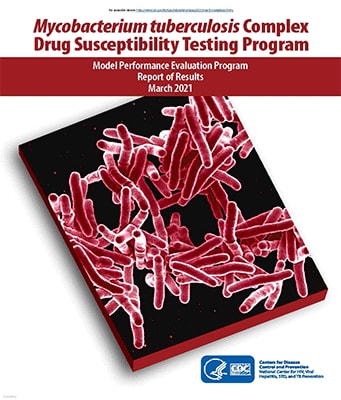
March 2021 Model Performance Evaluation Program (MPEP) Report Published
The purpose of this report is to present results of CDC’s Model Performance Evaluation Program (MPEP) for Mycobacterium tuberculosis complex (MTBC) drug susceptibility testing survey sent to participants in March 2021.

NCHHSTP Careers Webpage
Are you interested in joining our team at CDC? Our Careers webpage includes information on career paths, tips on interviewing, and more about our HIV, viral hepatitis, STDs, TB prevention and adolescent and school health activities. Other highlights include our workplace culture and ways we strengthen our highly qualified and diverse staff.

STD Awareness Week’s new campaign
For STD Awareness Week, we are releasing a new campaign. Prepare Before You’re There intends to help people navigate barriers to their sexual health. Participants start with a brief, interactive quiz to see if they may be at risk for a sexually transmitted infection (STI). They will then receive access to several “game plan” resources to help them make prevention decisions before going out or swiping right.
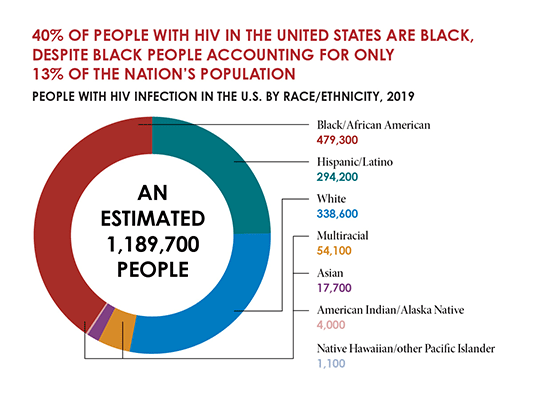
Despite overall progress in reducing HIV transmission in the United States, HIV continues to affect some groups more than others due to longstanding and ingrained barriers. In 2019, Black/African American people accounted for 13% of the U.S. population but 40% of people with HIV. In observance of National Black HIV/AIDS Awareness Day, NCHHSTP updated the media backgrounder, “HIV and Black/African American People in the U.S.”
The following media backgrounders have recently been updated as well:
- The State of the HIV Epidemic in the U.S.
- HIV in the U.S. by the Numbers – Current Year
- PrEP for HIV Prevention in the U.S.
To access our Center’s most recent resources for news media, check out the NCHHSTP newsroom.
Dr. Jonathan Mermin
@DrMerminCDC
- March 10: National Women and Girls HIV/AIDS Awareness Day
- March 20: National Native HIV/AIDS Awareness Day
- March 24: World TB Day
- April 10: National Youth HIV/AIDS Awareness Day
- April 18: National Transgender HIV Testing Day
- March 10: National Women and Girls HIV/AIDS Awareness Day
- March 20: National Native HIV/AIDS Awareness Day
- March 24: World TB Day
- April 10: National Youth HIV/AIDS Awareness Day
- April 18: National Transgender HIV Testing Day

Mary Cashin
Do you have feedback, story ideas, content you would like to see in the newsletter? Contact us
Get Connections. Your more interesting inbox awaits!
Subscribe now
Mary Cashin
Do you have feedback, story ideas, content you would like to see in the newsletter? Contact us
Get Connections in your inbox







